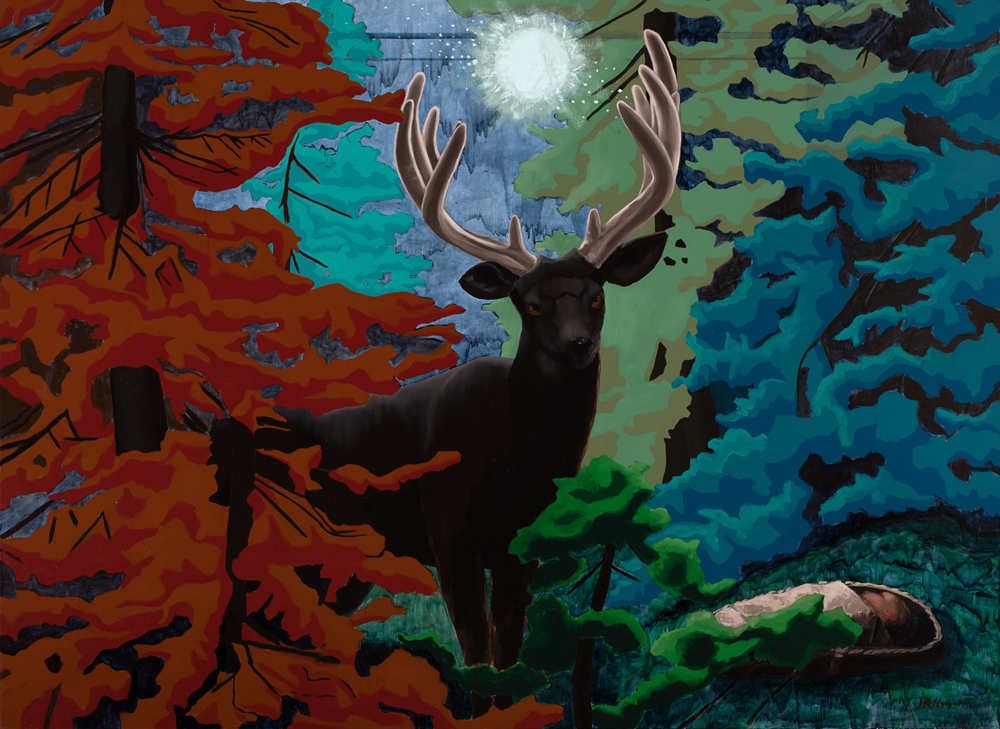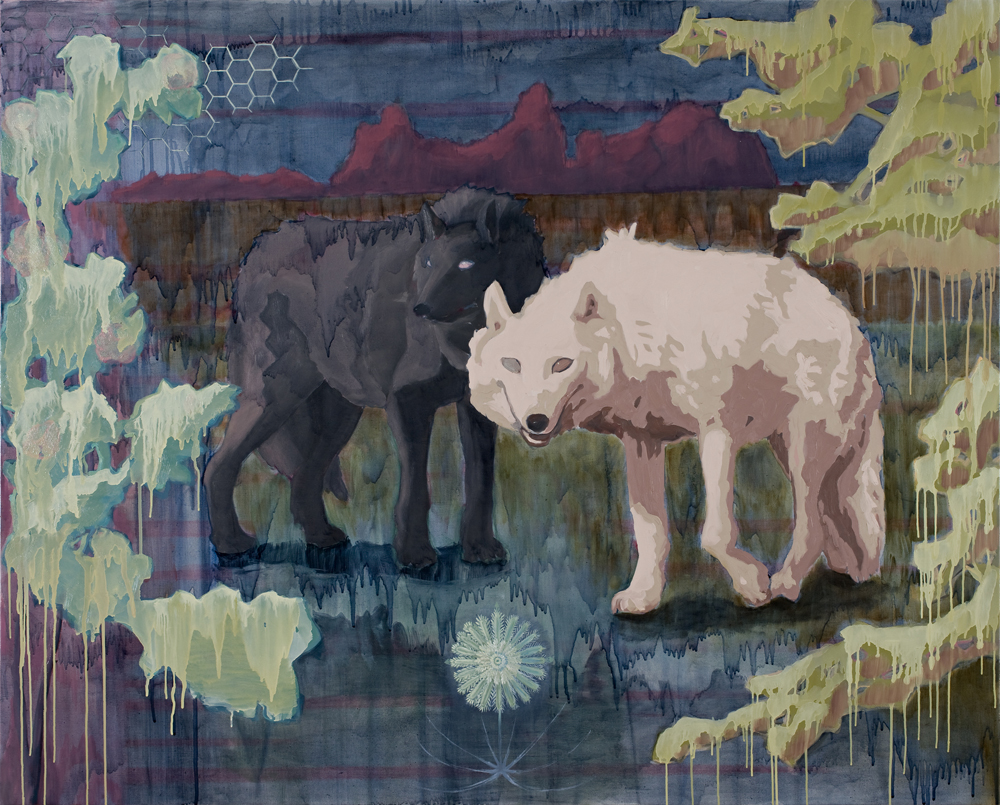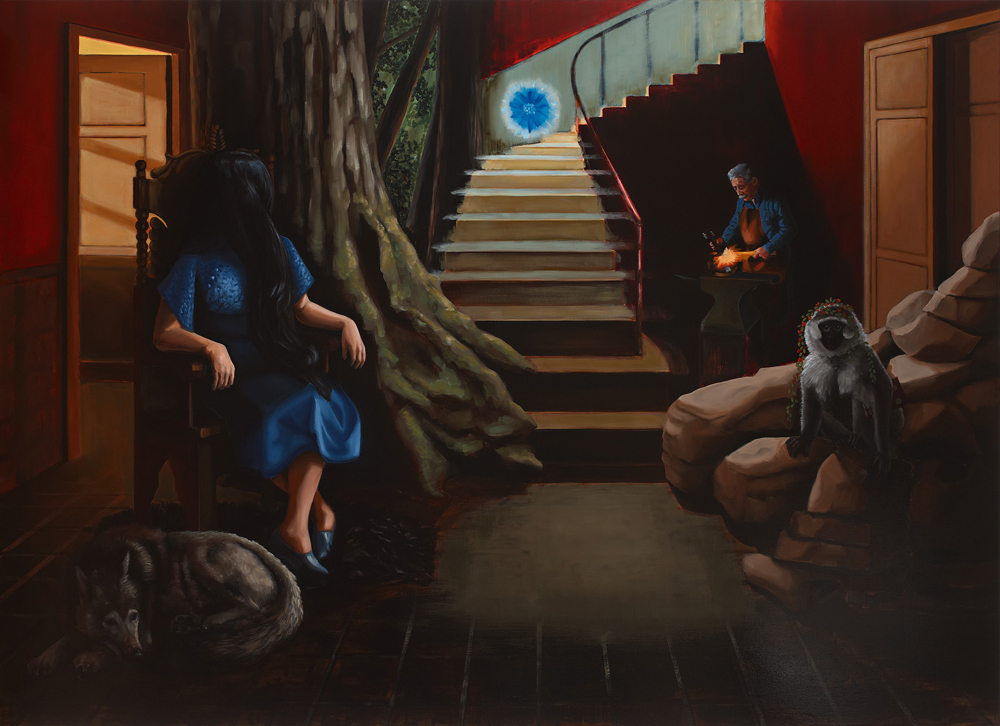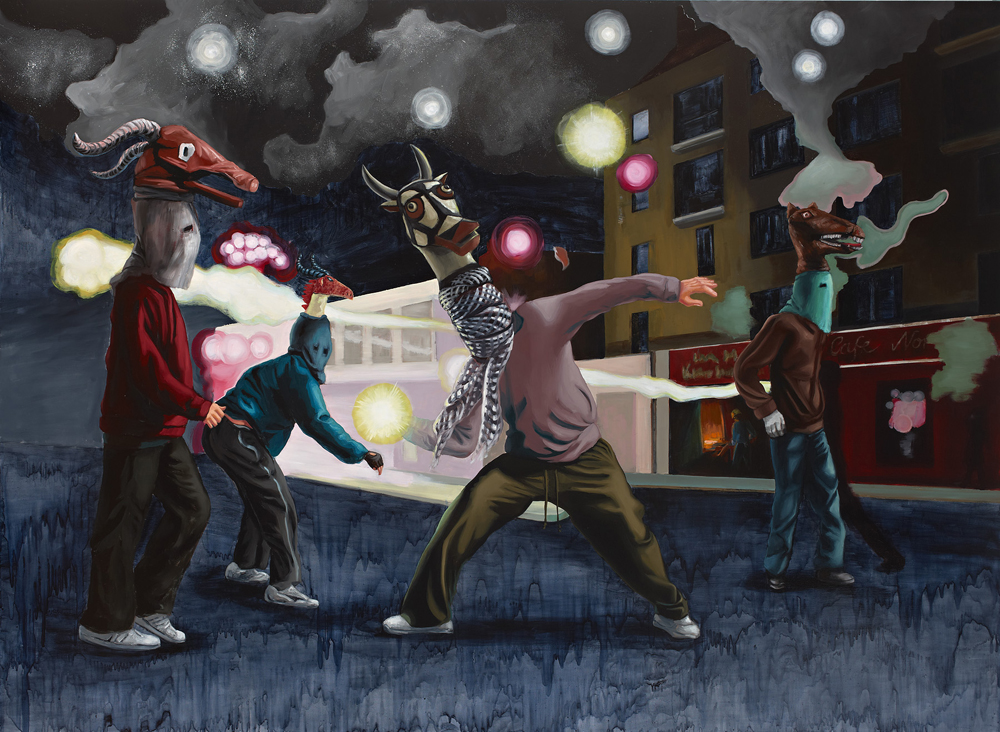Crossing the threshold with Artist Irene Wellm

Contemporary artist, Irene Wellm is the recipient of a $20,000 Australia Council New Works Grant for 2012. Timely funding as she sets off this week on her 6 month residency to Germany. Wellm is a painter of the darker recesses of imagination, drawn to the inner exploration of psychological realms. Her paintings evoke dream states where beings and beasts inhabit the interworlds, inviting us to participate in crossing the thresholds of converging and diverging realities. Art World Women spoke with Irene about the plans for her upcoming artists residency and her haunting, unearthly paintings.
Irene Wellm, Lysis, 2010, oil on linen, 145 x 198 cm
AWW: Irene, looking at your paintings is like stepping into someone’s dream. Can you tell us about the intersections of dreams and art?
IW: Dreams for me are a way of accessing the unconscious. They are a gateway to something much broader than the waking life – to the strange, the paradoxical, the dark and the light. I also use a method called Active Imagination during meditation that takes the dreaming onto a more conscious level. I don’t necessarily use what I see there in my art, but it certainly influences the process of creating new work. It influences how I find images and how they are put together. Dreams have had influence over many artists over time, and it’s not hard to see why.
AWW: What are the main concerns of your work?
IW: I look at the method of painting as a language – the endless variations of texture and colour that communicate a feeling or circumstance. With this, I balance with equal importance the psychological weight of the narrative. The paint surface is aimed at providing a gateway and relationship to the deeper metaphors.
AWW: Rich with symbolic language, your artwork references psychology and Jungian symbolism. Can you tell us more about this connection?
I was introduced to Jung and his theories as a young girl by my mother, who is a voracious reader and collected many books surrounding his ideas and other more philosophical and spiritual ideas. In my thirties I went further with a lot of soul searching using those principles with the guidance of a counsellor. In my late thirties, I left all that behind to reconnect with my painting self. Now in my forties, I am bringing it all together, and have requisitioned all those books from my mother’s bookshelves! I am so intrigued with the idea of communicating with the unconscious and the Self, and the rich symbolic language it evokes. It inspires all my work. To express this in painting, the German painter Neo Rauch once said that it was like taking hold of someone’s hand and walking with them to the edge of the abyss, to show them the awesome view. Just for a moment. I can relate to that.

AWW: Speaking of Jung and subconscious desires…Can you share with us one of your guilty passions?
IW: It used to be buying plants for my garden, and sneaking them home to plant before my husband saw. I currently need to find a new one. Guilty passion that is.
AWW: Achetypal beings and presences inhabit your paintings. Are there archetypes that recur for you? What is the significance of these for you?
IW: A good question. I still have nebulous ideas on this as I work intuitively. Our most basic psychological structure is formed by the archetypes, which means generally collective patterns of behaviour – how we can tend to react in the same way in certain situations. A constellating problem like upheaval or disruption in a society that cannot be dealt with may bring up a collective need for a Hero, for example. There has been a lot written on the current constellating of the Virgin archetype, the feminine energies, and I am interested in that. The term ‘virgin’ is meant here in its psychological connotation, referring to an inner attitude of being one-in-oneself. There are many expressions of this that find their way into my work, one of which is the black virgin.
AWW: How have changes in technology and in particular social media influenced you as an artist?
IW: Hugely. Having a computer to create collage with such ease, and access to unbelievable amounts of imagery limited only by your search capacity has helped make the initialising of the creative process much more fluid. The world of social media is one that I am still ambiguous about, but I use it to share my work. I’m not sure yet how much comes from it professionally, but in a friendship circle, it is a wonderful support for one who spends a lot of time alone.

AWW: What are your aspirations and intentions for your work?
IW: I have always been quite ambitious, and aspired to become a great painter. This is what drives me. I am always wanting to learn, explore, understand, and go further with my work. To drive it to be better than before. And like many artists before me, I think the next one will always be the one! It’s like chasing an elusive flame in the dark. My intentions are to allow for more slip-ups, more gaps, for unintentional things to come through, as I believe it makes for a more interesting painting. I want to create a painting that holds interest, keeps one looking and wondering, keeps the unknowing alive within the work by holding a paradox in balance.
AWW: Which women artists are you inspired by and why?
IW: Louise Bourgeois, Jude Rae, Pat Brassington, Rosa Loy, Susan Norrie, Anna Platten, Rosalind Piggot, Margaret Olley… (Where does one stop?) Crucially, all of these women follow/ed their own path, regardless. They also inspire me by either their painting technique (Rae, Olley, Platten), or the undercurrents I perceive in their work (Bourgeois, Norrie, Piggot, Brassington, Loy). Last year I discovered the beautiful work of German painter Miriam Vlamming – her technique gives me lots of inspiration – and just recently I have really been taken with the work of Carol Bove. She creates beautiful complex relationships between objects found and made.
AWW: Tell us about your first big break?
IW: A now-close friend, who I met at the VCA, introduced me to my first commercial dealer. It was the most generous act.
AWW: What do you look to as your cultural or artistic heritage?
IW: Heritage has always been a big question mark over my head. Culturally, I have Lithuanian and German heritage. I also have the dubious honour of being a first generation Australian, and all that entails. The first time I knew where ‘home’ is was when I went overseas, and I ached to return. I grew up with a feeling that I was only a guest here, but that has begun to dissipate over the last five years. I always wanted to be ritually welcomed to this land by a group of Aboriginal women, as if that would heIp, I don’t know why. Perhaps one day I will be. Artistically I have always found a heritage in Flemish and German painting – in the German Expressionists, and later Anselm Kiefer, and now in artists like Neo Rauch and other contemporary painters there.

AWW: If you could have anything in your studio – what would it be?
More space. I’d love to have enough space to line up several of my works at a time, and to leave finished works around to look at without them being at risk of damage. Oh, and someone to clean the house and call me when dinner’s ready. Greedy, I know.
AWW: In your recent exhibition “The Momentum of Evolution” you showed small collage works alongside your large, expansive paintings. Can you share some more about your process?
I am an oil painter, and I love to paint on oil-primed linen. It doesn’t absorb the initial layers of paint the way acrylic primer does. I love the smell of oil paint and mediums in my studio when I arrive in the morning. Sometimes I begin with an interesting photo I might have found, from my own collection, or from the Internet, and I play around with it on the computer as one might do with a collage. Sometimes the seed of an idea flashes through my mind, and then I go on a hunt for references or make my own, and piece it together. These days, I also like to create a cut-and paste-up collage, because I do things there that add unintentional elements to a work that doesn’t happen on a computer. I’m more carefree. After that, I begin washes on the canvas, and begin drawing up, trying to let another process begin. The collage work is a starting point, then the painting process takes over, and decisions get made along the way accordingly.
AWW: What do you do find most challenging as an artist?
Of late it is finding the courage to keep going. The first half of this year has been professionally and emotionally difficult for various reasons, and feelings of despair, of feeling invisible, and questions of ‘why am I doing this’ were circling around me. To keep going in these times is the most challenging thing, because a part of you tells you to stop wasting time and go out and get a real job. It can be quite demoralising, and hard work to quieten down. Thankfully recent events have given that voice a real hiding!

AWW: I hear you are about to jump on a plane and head off to Europe?
I am about to head off overseas on a residency I organised a couple of years ago. I have been funded at the last minute by an Australia Council New Work grant, which is manna from heaven! I will be taking three weeks to visit the places where my parents were born before being displaced by WW2 – a kind of pilgrimage. Then I will go to Leipzig to begin a 6-month residency, mostly working and traveling a little to take advantage of the proximity of all those wonderful art collections. There will be input from people there, and I intend to work very hard. I hope to create some new and interesting work, and will have the opportunity to exhibit it there and back here in Australia.
See more of the work of artist Irene Wellm
Website: Irene Wellm
Facebook: Irene Wellm – Visual Artist